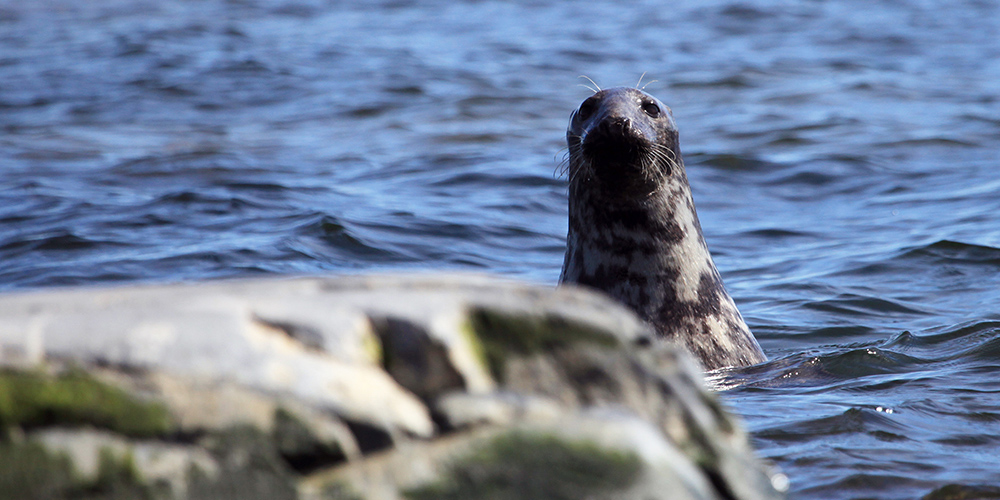Seal Reserves Help Sustain Seal Populations
Seven seal reserves were established by statute in state-owned sea waters In 2001. The main purpose of these reserves is to protect Grey Seals (Halichoerus grypus) and their habitats. Some of these areas are also important for the preservation of the Ringed Seal (Pusa hispida botnica).

These areas are managed by Metsähallitus, Parks & Wildlife Finland. The established seal reserves not only protect the seals but also help the research and the tracking of seal populations.
Rocky islets which are the seal’s habitat are also valuable marine biotopes. The established reserves are all totally or partially part of the Natura 2000 network.
The outer boundary of each reserve is at least one nautical mile (1,852 m) from an islet or a group of islets seals inhabit. The combined area of these reserves measures 188 sq. km and covers 0.37% of Finland’s coastal waters.
The reserves are marked on official maps and charts. Their boundaries area not marked outdoors.
The Seal Reserves are Sandkallan–Stora Kölhällen, Kallbådan, Mastbådan, Grimsörarna, Södra Sandbäck–Sandbäck, Snipansgrund–Medelkalla and Möyly.
Why Does Finland Need Seal Reserves
The number of seals in the Baltic Sea dropped drastically during the 20th century. At the lowest the population numbered only a few thousand individuals. The drop was caused, up until the 1960s, by overhunting and after this environmental toxins had an adverse effect on seals breeding. At the end of the 20th century the seal population started to recover slowly.
During aerial surveys of the Baltic Sea made in 2017 by the Natural Resources Institute of Finland, approximately 30,300 Grey Seals were spotted on islets, with over 9,600 being spotted in Finnish marine areas.
Grey Seals flock to rocky islets on the edge of the open sea each year when the ice cover melts. The islets are important resting places for seals when they shed their fur in May-June, after the windy season in summer and also, if weather conditions permit, in autumn. As seals are social animals they sometimes lay on the islets in dense groups. During winters when there is no ice or very little ice covering the sea, Finland’s southwest islets are also calving areas. Seals move along the coast from one islet to another over large areas, sometimes even travelling a hundred kilometres a day. Islets surrounded by vast waters are the central parts of seal reserves. These reserves ensure that seals can rest on the islets without being disturbed.
Entering Seal Reserves
Entering seal reserves is forbidden year-round in an area within half a nautical mile (926 m) of islets and groups of islets marked on reserve maps, if boaters do not have Metsähallitus permits. Boaters are allowed within reserves as long as they stay half a nautical mile from islets during the period 16.6.–31.1. At other times boaters need a Metsähallitus permit to enter any part of a reserve.
Boating is allowed within seal reserves without a Metsähallitus permit, if you stay on official ship lanes. Officials monitoring sea areas, in charge of search and rescue activities and maintenance of safety equipment are allowed within reserves without a Metsähallitus permit.
Additionally there is a route through Sandkallan-Stora Kölhällen seal reserve along which the public can travel. Mastbådan seal reserve and Grimsörarna seal reserve (Archipelago National Park) as well as Möyly seal reserve (Bothnian Bay National Park) share a boundary with a National Park. Rules on entering areas within the National Parks which are near seal islets, are outlined in the parks’ rules and regulations.
Fishing and Hunting and the Seal Reserves
Professional fishermen are allowed to practice their trade in reserves, if they stay at least half a nautical mile (926 m) from islets or groups of islets marked on reserve maps and as long as they use troll fishing techniques, thin threaded nets or fish traps which seals cannot get trapped in.
Hunting is completely forbidden in all parts of seal reserves.